Gastronomy as a Sign of the Identity and Cultural Heritage of Tourist Destinations: A Bibliometric Analysis 2001–2020
Abstract
1. Introduction
2. Literature Review
2.1. Gastronomic Heritage and Economic Development
2.2. Gastronomic Heritage as an Attraction Factor for Tourism
2.3. Gastronomic Heritage and Cultural Patterns
2.4. Gastronomic Heritage as a Hallmark of Tourist Destinations
2.5. Literature Reviews Related to Gastronomic Heritage
3. Materials and Methods
3.1. Data Collection
3.2. Coding Criteria
4. Results and Discussion
4.1. Bibliometric Analysis
4.1.1. Evolution of Scientific Articles on Gastronomic Heritage
4.1.2. Main Countries Publishing Articles on Gastronomic Heritage
4.1.3. Main Scientific Journals with Articles on Gastronomic Heritage
4.1.4. Main Universities and Authors on Gastronomic Heritage
4.1.5. Articles on Gastronomic Heritage per Destination and Region
4.2. Analysis of Asian and European Case Studies
4.2.1. Most Common Keywords
4.2.2. Relations between Gastronomic Heritage and Sustainability
4.2.3. Subject, Methodology, Data Source and Tourist Destination
5. Conclusions
Author Contributions
Funding
Institutional Review Board Statement
Informed Consent Statement
Conflicts of Interest
References
- Laroche, M.; Kim, C.; Tomiuk, M.A.; Belisle, D. Similarities in Italian and Greek multidimensional ethnic identity: Some implications for food consumption. Can. J. Adm. Sci. Can. Des. Sci. L’administration 2005, 22, 143–167. [Google Scholar] [CrossRef]
- Nor, N.M.; Sharif, M.S.M.; Zahari, M.S.M.; Salleh, H.M.; Isha, N.; Muhammad, R. The transmission modes of Malay traditional food knowledge within generations. Procedia Soc. Behav. Sci. 2012, 50, 79–88. [Google Scholar] [CrossRef]
- Avieli, N. What is ‘local food?’ Dynamic culinary heritage in the world heritage site of Hoi An, Vietnam. J. Herit. Tour. 2013, 8, 120–132. [Google Scholar] [CrossRef]
- UNESCO. Report on the Preliminary Study on the Advisability of Regulating Internationally, through a New Standard-Setting Instrument, the Protection of Traditional Culture and Folklore; United Nations Educational, Scientific and Cultural Organization: Paris, France, 2001. [Google Scholar]
- UNESCO. Basic Texts of the 2003 Convention for the Safeguarding of the Intangible Cultural Heritage; United Nations Educational, Scientific and Cultural Organization: Paris, France, 2020. [Google Scholar]
- UNESCO. Browse the Lists of Intangible Cultural Heritage. Available online: https://ich.unesco.org/en/lists (accessed on 1 January 2021).
- UNWTO. UNWTO Tourism Definitions; World Tourism Organization: Madrid, Spain, 2019; ISBN 9789284420858. [Google Scholar]
- Bessière, J. Local development and heritage: Traditional food and cuisine as tourist attractions in rural areas. Sociol. Rural. 1998, 38, 21–34. [Google Scholar] [CrossRef]
- Parsa, H.G. Cultural heritage of American food habits and implications for the hospitality industry. Marriage Fam. Rev. 1998, 28, 23–48. [Google Scholar] [CrossRef]
- Van Westering, J. Heritage and gastronomy: The pursuits of the ‘new tourist’. Int. J. Herit. Stud. 1999, 5, 75–81. [Google Scholar] [CrossRef]
- Van der Spiegel, M.; van der Fels-Klerx, H.J.; Sterrenburg, P.; van Ruth, S.M.; Scholtens-Toma, I.M.J.; Kok, E.J. Halal assurance in food supply chains: Verification of halal certificates using audits and laboratory analysis. Trends Food Sci. Technol. 2012, 27, 109–119. [Google Scholar] [CrossRef]
- Kivela, J.; Crotts, J.C. Tourism and gastronomy: Gastronomy’s influence on how tourists experience a destination. J. Hosp. Tour. Res. 2006, 30, 354–377. [Google Scholar] [CrossRef]
- Oliveira, B.S.; Tricárico, L.T.; Sohn, A.P.L.; Pontes, N. The culinary intangible cultural heritage of UNESCO: A review of journal articles in EBSCO platform. J. Culin. Sci. Technol. 2020, 18, 138–156. [Google Scholar] [CrossRef]
- Rinaldi, C. Food and gastronomy for sustainable place development: A multidisciplinary analysis of different theoretical approaches. Sustainability 2017, 9, 1748. [Google Scholar] [CrossRef]
- Rachão, S.; Breda, Z.; Fernandes, C.; Joukes, V. Food tourism and regional development: A systematic literature review. Eur. J. Tour. Res. 2019, 21, 33–49. [Google Scholar]
- Castells-Valdivielso, M. El reconocimiento internacional de la dieta mediterránea como patrimonio inmaterial: Oportunidades para el turismo gastronómico balear. Boletín Gestión Cult. 2008, 17, 2–16. [Google Scholar]
- Bessière, J. ‘Heritagisation’, a challenge for tourism promotion and regional development: An example of food heritage. J. Herit. Tour. 2013, 8, 275–291. [Google Scholar] [CrossRef]
- Kranjčević, J.; Gartner, W.C. Sectoral heritage characteristics for wine region development: The influence of agriculture, culture and tourism. Acta Tur. 2019, 31, 7–34. [Google Scholar] [CrossRef]
- Said, E.W. Orientalism; Routledge & Kegan Paul Ltd.: London, UK, 1978. [Google Scholar]
- UNWTO; World Tourism Organization (WTO). Tourism Highlights 2002; WTO: Madrid, Spain, 2002. [Google Scholar]
- De Roest, K.; Menghi, A. Reconsidering “traditional” food: The case of Parmigiano Reggiano cheese. Sociol. Rural. 2000, 40, 439–451. [Google Scholar] [CrossRef]
- Kim, Y.G.; Eves, A.; Scarles, C. Building a model of local food consumption on trips and holidays: A grounded theory approach. Int. J. Hosp. Manag. 2009, 28, 423–431. [Google Scholar] [CrossRef]
- Tomić, M.; Deronja, K.; Tudor Kalit, M.; Mesić, Ž. Consumers’ attitudes towards ethnic food consumption. J. Cent. Eur. Agric. 2018, 19, 349–367. [Google Scholar] [CrossRef]
- Bessière, J.; Tibere, L. Traditional food and tourism: French tourist experience and food heritage in rural spaces. J. Sci. Food Agric. 2013, 93, 3420–3425. [Google Scholar] [CrossRef] [PubMed]
- Daries, N.; Marine-Roig, E.; Ferrer-Rosell, B.; Cristobal-Fransi, E. Do high-quality restaurants act as pull factors to a tourist destination? Tour. Anal. 2021, 26, 195–210. [Google Scholar] [CrossRef]
- Crang, P. Performing the tourist product. In Touring Cultures: Transformations of Travel and Theory; Rojek, C., Urry, J., Eds.; Routledge: London, UK, 1997; pp. 137–154. [Google Scholar]
- Gyimóthy, S.; Mykletun, R.J. Scary food: Commodifying culinary heritage as meal adventures in tourism. J. Vacat. Mark. 2009, 15, 259–273. [Google Scholar] [CrossRef]
- Pérez Gálvez, J.C.; Pemberthy Gallo, L.S.; Medina-Viruel, M.J.; López-Guzmán, T. Segmentation of tourists that visit the city of Popayán (Colombia) according to their interest in its gastronomy. J. Culin. Sci. Technol. 2021, 19, 149–170. [Google Scholar] [CrossRef]
- Daries, N.; Cristobal-Fransi, E.; Ferrer-Rosell, B.; Marine-Roig, E. Behaviour of culinary tourists: A segmentation study of diners at top-level restaurants. Intang. Cap. 2018, 14, 332–355. [Google Scholar] [CrossRef]
- Vanhonacker, F.; Verbeke, W.; Guerrero, L.; Claret, A.; Contel, M.; Scalvedi, L.; Zakowska-Biemans, S.; Gutkowska, K.; Sulmont-Rossé, C.; Raude, J.; et al. How European consumers define the concept of traditional food: Evidence from a survey in six countries. Agribusiness 2010, 26, 453–476. [Google Scholar] [CrossRef]
- Ramli, A.; Zahari, M.M.; Ishak, N.; Sharif, M.M. Food heritage and nation food identity formation. Hosp. Tour. Synerg. Creat. Innov. Res. 2013, 407, 162–168. [Google Scholar]
- Noriza, I.; Zahari, M.S.M.; Shazali, M.S.; Rosmaliza, M.; Hannita, S. Acculturation, foodways and Malaysian food identity. In Current Issues in Hospitality and Tourism: Research and Innovations; Zainal, A., Radzi, S.M., Hashim, R., Chik, C.T., Abu, R., Eds.; Routledge: London, UK, 2012; pp. 359–363. [Google Scholar]
- Mukherji, J. Is cultural assimilation related to environmental attitudes and behaviors? ACR N. Am. Adv. 2005, 32, 415–421. [Google Scholar]
- Cleveland, M.; Laroche, M.; Pons, F.; Kastoun, R. Acculturation and consumption: Textures of cultural adaptation. Int. J. Intercult. Relat. 2009, 33, 196–212. [Google Scholar] [CrossRef]
- McCoy, L. Food Heritage Planning Proposals: Planning for Food Heritage Celebrations in Central Virginia. 2012. Available online: http://www.virginia.edu (accessed on 1 June 2021).
- Thompson, C.J.; Tambyah, S.K. Trying to be cosmopolitan. J. Consum. Res. 1999, 26, 214–241. [Google Scholar] [CrossRef]
- Gilly, M.C. The consumer acculturation of expatriate americans. In North American Advances in Consumer Research; Kardes, F.R., Sujan, M., Eds.; Association for Consumer Research: Provo, UT, USA, 1995; Volume NA-22, pp. 506–510. [Google Scholar]
- Allen, D.E. Toward a theory of consumer choice as sociohistorically shaped practical experience: The fits-like-a-glove (FLAG) framework. J. Consum. Res. 2002, 28, 515–532. [Google Scholar] [CrossRef]
- Marshall, D. Food as ritual, routine or convention. Consum. Mark. Cult. 2005, 8, 69–85. [Google Scholar] [CrossRef]
- Bardhi, F.; Ostberg, J.; Bengtsson, A. Negotiating cultural boundaries: Food, travel and consumer identities. Consum. Mark. Cult. 2010, 13, 133–157. [Google Scholar] [CrossRef]
- Alonso, A.D.; Krajsic, V. Food heritage down under: Olive growers as mediterranean ‘food ambassadors’. J. Herit. Tour. 2013, 8, 158–171. [Google Scholar] [CrossRef]
- Parasecoli, F. Food, identity, and cultural reproduction in immigrant communities. Soc. Res. 2014, 81, 415–439. [Google Scholar]
- Timothy, D.J. Cultural Heritage and Tourism: An Introduction; Channel View Publications: Bristol, UK, 2011; Volume 4. [Google Scholar]
- Ritzer, G.; Liska, A. ‘McDisneyization’ and ‘post-tourism’: Complementary perspectives on contemporary tourism. In Touring Cultures: Transformations of Travel and Theory; Rojek, C., Urry, J., Eds.; Routledge: London, UK, 1997; pp. 96–112. [Google Scholar]
- Ron, A.S.; Timothy, D.J. The land of milk and honey: Biblical foods, heritage and holy land tourism. J. Herit. Tour. 2013, 8, 234–247. [Google Scholar] [CrossRef]
- Richards, G. An overview of food and tourism trends and policies. In Food and the tourism experience: The OECD-Korea Workshop; OECD Publishing: Paris, France, 2012; pp. 13–46. [Google Scholar]
- UNWTO. Second Global Report on Gastronomy Tourism; World Tourism Organization: Madrid, Spain, 2017. [Google Scholar]
- Mora, D.; Solano-Sánchez, M.Á.; López-Guzmán, T.; Moral-Cuadra, S. Gastronomic experiences as a key element in the development of a tourist destination. Int. J. Gastron. Food Sci. 2021, 25, 100405. [Google Scholar] [CrossRef]
- Quan, S.; Wang, N. Towards a structural model of the tourist experience: An illustration from food experiences in tourism. Tour. Manag. 2004, 25, 297–305. [Google Scholar] [CrossRef]
- López-Guzmán, T.; Jesus, M.M. Turismo, cultura y gastronomía. Una aproximación a las rutas culinarias [Tourism, culture and gastronomy. An approach to the culinary routes]. Tour. Manag. Stud. 2011, 1, 915–922. [Google Scholar]
- De Miguel Molina, M.; de Miguel Molina, B.; Santamarina Campos, V.; del Val Segarra Oña, M. Intangible heritage and gastronomy: The impact of UNESCO gastronomy elements. J. Culin. Sci. Technol. 2016, 14, 293–310. [Google Scholar] [CrossRef]
- Okumus, B.; Koseoglu, M.A.; Ma, F. Food and gastronomy research in tourism and hospitality: A bibliometric analysis. Int. J. Hosp. Manag. 2018, 73, 64–74. [Google Scholar] [CrossRef]
- Lyu, V.C.; Lai, I.K.W.; Ting, H.; Zhang, H. Destination food research: A bibliometric citation review (2000–2018). Br. Food J. 2020, 122, 2045–2057. [Google Scholar] [CrossRef]
- Durán Sánchez, A.; del Río Rama, M.D.L.C.; Álvarez García, J. Bibliometric analysis of publications on wine tourism in the databases Scopus and WoS. Eur. Res. Manag. Bus. Econ. 2017, 23, 8–15. [Google Scholar] [CrossRef]
- Montella, M. Wine tourism and sustainability: A review. Sustainability 2017, 9, 113. [Google Scholar] [CrossRef]
- Gómez, M.; Pratt, M.A.; Molina, A. Wine tourism research: A systematic review of 20 vintages from 1995 to 2014. Curr. Issues Tour. 2019, 22, 2211–2249. [Google Scholar] [CrossRef]
- Amarando, M.; Assenov, I.; Visuthismajarn, P. A systematic review of sustainable wine tourism research in Asia 2000–2018. Afr. J. Hosp. Tour. Leis. 2019, 8, 1–24. [Google Scholar]
- De Jong, A.; Palladino, M.; Puig, R.G.; Romeo, G.; Fava, N.; Cafiero, C.; Skoglund, W.; Varley, P.; Marcianò, C.; Laven, D.; et al. Gastronomy tourism: An interdisciplinary literature review of research areas, disciplines, and dynamics. J. Gastron. Tour. 2018, 3, 131–146. [Google Scholar] [CrossRef]
- Rodríguez-López, M.E.; Alcántara-Pilar, J.M.; Del Barrio-García, S.; Muñoz-Leiva, F. A review of restaurant research in the last two decades: A bibliometric analysis. Int. J. Hosp. Manag. 2020, 87, 102387. [Google Scholar] [CrossRef]
- Donthu, N.; Kumar, S.; Mukherjee, D.; Pandey, N.; Lim, W.M. How to conduct a bibliometric analysis: An overview and guidelines. J. Bus. Res. 2021, 133, 285–296. [Google Scholar] [CrossRef]
- Corral-Marfil, J.-A.; Cànoves-Valiente, G. An approach to tourism research in Spain. Tour. Soc. Sci. Ser. 2016, 22, 167–189. [Google Scholar]
- Lee, H.A.; Law, R. Diversity in statistical research techniques: An analysis of refereed research articles in the journal of travel & tourism marketing between 1992 and 2010. J. Travel Tour. Mark. 2012, 29, 37–41. [Google Scholar]
- Aria, M.; Cuccurullo, C. Bibliometrix: An R-tool for comprehensive science mapping analysis. J. Inf. 2017, 11, 959–975. [Google Scholar] [CrossRef]
- Stemler, S. An overview of content analysis. Pract. Assess. Res. Eval. 2001, 7, 17. [Google Scholar]
- Gallardo-Gallardo, E.; Nijs, S.; Dries, N.; Gallo, P. Towards an understanding of talent management as a phenomenon-driven field using bibliometric and content analysis. Hum. Resour. Manag. Rev. 2015, 25, 264–279. [Google Scholar] [CrossRef]
- Boyce, J.; Bowers, A.J. Toward an evolving conceptualization of instructional leadership as leadership for learning: Meta-narrative review of 109 quantitative studies across 25 years. J. Educ. Adm. 2018, 56, 1–20. [Google Scholar] [CrossRef]
- Strydom, N.; Els, G. A bibliometric analysis of the Journal of Economic and Financial Sciences (2007-2016). J. Econ. Financ. Sci. 2016, 9, 951–974. [Google Scholar] [CrossRef][Green Version]
- Anderson, M.H.; Lemken, R.K. Citation context analysis as a method for conducting rigorous and impactful literature reviews. Organ. Res. Methods 2020. [Google Scholar] [CrossRef]
- Everett, S.; Aitchison, C. The role of food tourism in sustaining regional identity: A case study of Cornwall, South West England. J. Sustain. Tour. 2008, 16, 150–167. [Google Scholar] [CrossRef]
- Lin, Y.-C.; Pearson, T.E.; Cai, L.A. Food as a form of destination identity: A tourism destination brand perspective. Tour. Hosp. Res. 2011, 11, 30–48. [Google Scholar] [CrossRef]
- Fox, R. Reinventing the gastronomic identity of Croatian tourist destinations. Int. J. Hosp. Manag. 2007, 26, 546–559. [Google Scholar] [CrossRef]
- Contò, F.; Vrontis, D.; Fiore, M.; Thrassou, A. Strengthening regional identities and culture through wine industry cross border collaboration. Br. Food J. 2014, 116, 1788–1807. [Google Scholar] [CrossRef]
- Nilsson, J.H.; Svärd, A.-C.; Widarsson, A.; Wirell, T. “Cittáslow” eco-gastronomic heritage as a tool for destination development. Curr. Issues Tour. 2011, 14, 373–386. [Google Scholar] [CrossRef]
- Ganzaroli, A.; De Noni, I.; van Baalen, P. Vicious advice: Analyzing the impact of TripAdvisor on the quality of restaurants as part of the cultural heritage of Venice. Tour. Manag. 2017, 61, 501–510. [Google Scholar] [CrossRef]
- Josiam, B.M.; Mattson, M.; Sullivan, P. The Historaunt: Heritage tourism at Mickey’s Dining Car. Tour. Manag. 2004, 25, 453–461. [Google Scholar] [CrossRef]
- Kim, S.; Iwashita, C. Cooking identity and food tourism: The case of Japanese udon noodles. Tour. Recreat. Res. 2016, 41, 89–100. [Google Scholar] [CrossRef]
- Lin, M.P.; Marine-Roig, E.; Llonch-Molina, N. Gastronomic experience (co)creation: Evidence from Taiwan and Catalonia. Tour. Recreat. Res. 2021, 1–16. [Google Scholar] [CrossRef]
- Hodges, M. Food, time, and heritage tourism in Languedoc, France. Hist. Anthropol. Chur. 2001, 12, 179–212. [Google Scholar] [CrossRef]
- Dulaǔ, A.V.; Coroş, M.M.; Coroş, M.E. The place of the public administration and gastronomic heritage in the destination branding and tourism promotion. WSEAS Trans. Bus. Econ. 2010, 7, 402–413. [Google Scholar]
- Kavrečič, P. Interpretation of Istrian food: From basic need to heritage. Glas. SED 2014, 54, 37–42. [Google Scholar]
- Lourenço-Gomes, L.; Pinto, L.M.C.; Rebelo, J. Wine and cultural heritage. the experience of the Alto Douro Wine Region. Wine Econ. Policy 2015, 4, 78–87. [Google Scholar] [CrossRef]
- Prat Forga, J.M.; Cànoves Valiente, G. Cultural change and industrial heritage tourism: Material heritage of the industries of food and beverage in Catalonia (Spain). J. Tour. Cult. Chang. 2017, 15, 265–286. [Google Scholar] [CrossRef]
- Alder, J. Expressions of diasporic identity: Travel and food as signifiers of Polish identity. Tour. Cult. Commun. 2015, 15, 205–214. [Google Scholar] [CrossRef]
- Da Silva, A.L.; Fernão-Pires, M.J.; Bianchi-de-Aguiar, F. Portuguese vines and wines: Heritage, quality symbol, tourism asset. Cienc. E Tec. Vitivinic. 2018, 33, 31–46. [Google Scholar]
- Skinner, W. ‘A gift from God’: Autochthonous grapes and wine heritage on the island of Hvar, Croatia. J. Wine Res. 2019, 30, 294–311. [Google Scholar] [CrossRef]
- Skowronek, E.; Brzezińska-Wójcik, T.; Stasiak, A. Culinary heritage as an opportunity to make lubelskie voivodeship’s tourist offer more attractive (E Poland). Quaest. Geogr. 2019, 38, 85–95. [Google Scholar] [CrossRef]
- Canovi, M. Resistance to agritourism diversification: An analysis of winery owners’ identities. Tour. Manag. Perspect. 2019, 32, 100566. [Google Scholar] [CrossRef]
- Baraja Rodríguez, E.; Herrero Luque, D.; Martínez Arnáiz, M.; Plaza Gutiérrez, J.I. Tourism and wine development in mountain areas with “high heritage density”. Cuad. Tur. 2019, 43, 97–122. [Google Scholar] [CrossRef]
- Mercer, L.K.; Song, H.R. Catalanidad in the kitchen: Tourism, gastronomy and identity in modern and contemporary Barcelona. Bull. Span. Stud. 2020, 97, 659–680. [Google Scholar] [CrossRef]
- Pérez-Gálvez, J.C.; Medina-Viruel, M.J.; Jara-Alba, C.; López-Guzmán, T. Segmentation of food market visitors in World Heritage Sites. Case study of the city of Córdoba (Spain). Curr. Issues Tour. 2021, 24, 1139–1153. [Google Scholar] [CrossRef]
- Canovi, M.; Mordue, T.; Lyon, A. The impact of wine tourism involvement on winery owners’ identity processes. Tour. Plan. Dev. 2020, 17, 573–590. [Google Scholar] [CrossRef]
- Fusté-Forné, F. Say Gouda, say cheese: Travel narratives of a food identity. Int. J. Gastron. Food Sci. 2020, 22, 100252. [Google Scholar] [CrossRef]
- Andrade-Suárez, M.; Caamaño-Franco, I. The relationship between industrial heritage, wine tourism, and sustainability: A case of local community perspective. Sustainability 2020, 12, 7453. [Google Scholar] [CrossRef]
- Albert, K. Introducing historical landscape in the cultural heritage conservation through the example of the Tokaj wine region in Hungary. Acta Univ. Carol. Geogr. 2020, 55, 112–122. [Google Scholar] [CrossRef]
- Dursteler, E.R.; Yemek, A.; Çelebi, E.; Ali, M. Infidel foods: Food and identity in early modern Ottoman travel literature. Osman. Araştırmaları 2012, 39, 142–160. [Google Scholar]
- Dursteler, E.R. Bad bread and the “outrageous drunkenness of the Turks”: Food and identity in the accounts of early modern European travelers to the Ottoman Empire. J. World Hist. 2014, 25, 203–228. [Google Scholar] [CrossRef]
- Raghavan, A.; Asia, S.; Singh, V. Circuits of authenticity: Parsi food, identity, and globalisation in 21st century Mumbai. Econ. Polit. Wkly. 2015, 50, 69–74. [Google Scholar]
- Torabi Farsani, N.; Zeinali, H.; Moaiednia, M. Food heritage and promoting herbal medicine-based niche tourism in Isfahan, Iran. J. Herit. Tour. 2018, 13, 77–87. [Google Scholar] [CrossRef]
- de St. Maurice, G. Everything but the taste: Kyoto’s Shishigatani Squash as culinary heritage. Food Cult. Soc. 2017, 20, 281–301. [Google Scholar]
- Quee-Ling, L.; Ab Karim, M.S.; Awang, K.W.; Abu Bakar, A.Z. Profiles of gastronomic tourists visiting Malacca and George Town, world heritage site(s) of Malaysia. Asia-Pac. J. Innov. Hosp. Tour. 2017, 6, 99–120. [Google Scholar]
- Latiff, K.; Ng, S.I.; Aziz, Y.A.; Kamal Basha, N. Food authenticity as one of the stimuli to world heritage sites. Br. Food J. 2019, 122, 1755–1776. [Google Scholar] [CrossRef]
- Suna, B.; Alvarez, M.D. Gastronomic identity of Gaziantep: Perceptions of tourists and residents. Adv. Hosp. Tour. Res. 2019, 7, 16–187. [Google Scholar] [CrossRef]
- Sharma, S.; Batra, D.; Kumar, S. Culinary heritage of rajasthan state: An analysis of the satisfaction level. Int. J. Adv. Sci. Technol. 2020, 29, 8881–8891. [Google Scholar]
- Sahoo, D. Promoting culinary heritages as a destination attraction: A case study of ancient temple food “Mahaaprasaada”. Int. J. Relig. Tour. Pilgr. 2020, 8, 60–76. [Google Scholar]
- Tunming, M.N.; Chaigasem, T.; Siriwong, P.; Ngowtanasuwan, G. The strategy development of gastronomic tourism based on Tai-Dam’s ethnic indigenous identities in Thailand. Afr. J. Hosp. Tour. Leis. 2020, 9, 1–14. [Google Scholar]
- Duan, Y.-C. (Bob); Ma, E.; Arcodia, C.; Hsiao, A. The xiao zi effect on motivation to visit wineries from an identity perspective: The case of China. J. Hosp. Tour. Manag. 2020, 45, 359–369. [Google Scholar] [CrossRef]
- Khatami, F.; Ferraris, A.; De Bernardi, P.; Cantino, V. The relationship between food heritage and clan culture: Is “familiness” the missing link in SMEs? Br. Food J. 2020, 123, 337–354. [Google Scholar] [CrossRef]
- Mercado, J.M.T.; Andalecio, A.B.P. Ysla de panciteria: A preliminary study on the culinary heritage significance of pancit using the heritage documentation approach-the case of Luzon Island, Philippines. J. Ethn. Foods 2020, 7, 19. [Google Scholar] [CrossRef]
- Wang, C. Creating a wine heritage in Japan. Asian Anthropol. 2021, 20, 61–76. [Google Scholar] [CrossRef]
- Marine-Roig, E. Destination image analytics through traveller-generated content. Sustainability 2019, 11, 3392. [Google Scholar] [CrossRef]
- Sun, W.; Tang, S.; Liu, F. Examining perceived and projected destination image: A social media content analysis. Sustainability 2021, 13, 3354. [Google Scholar] [CrossRef]
- Park, D.-H.; Lee, S. UGC sharing motives and their effects on UGC sharing intention from quantitative and qualitative perspectives: Focusing on content creators in South Korea. Sustainability 2021, 13, 9644. [Google Scholar] [CrossRef]
- Marine-Roig, E. Measuring online destination image, satisfaction, and loyalty: Evidence from Barcelona districts. Tour. Hosp. 2021, 2, 4. [Google Scholar] [CrossRef]
- UNESCO. Convention on the Protection and Promotion of the Diversity of Cultural Expressions; United Nations Educational, Scientific and Cultural Organization: Paris, France, 2005. [Google Scholar]
- Daries, N.; Cristobal-Fransi, E.; Marine-Roig, E. Deployment of restaurants websites’ marketing features: The case of Spanish Michelin-starred restaurants. Int. J. Hosp. Tour. Adm. 2019, 20, 249–280. [Google Scholar]
- Marine-Roig, E.; Ferrer-Rosell, B.; Daries, N.; Cristobal-Fransi, E. Measuring gastronomic image online. Int. J. Env. Res. Public Health 2019, 16, 4631. [Google Scholar] [CrossRef]
- Kattiyapornpong, U.; Ditta-Apichai, M.; Chuntamara, C. Exploring gastronomic tourism experiences through online platforms: Evidence from Thai local communities. Tour. Recreat. Res. 2021, 1–17. [Google Scholar] [CrossRef]
- Espeitx Bernat, E. Patrimonio alimentario y turismo: Una relación singular [Food heritage and tourism: A unique relationship]. PASOS Rev. Tur. Y Patrim. Cult. 2004, 2, 193–213. [Google Scholar]
- Chang, R.C.Y.; Mak, A.H.N. Understanding gastronomic image from tourists’ perspective: A repertory grid approach. Tour. Manag. 2018, 68, 89–100. [Google Scholar] [CrossRef]
- Moira, P.; Mylonopoulos, D.; Kontoudaki, A. Gastronomy as a form of cultural tourism: A Greek typology. Tims Acta 2015, 9, 135–148. [Google Scholar] [CrossRef]

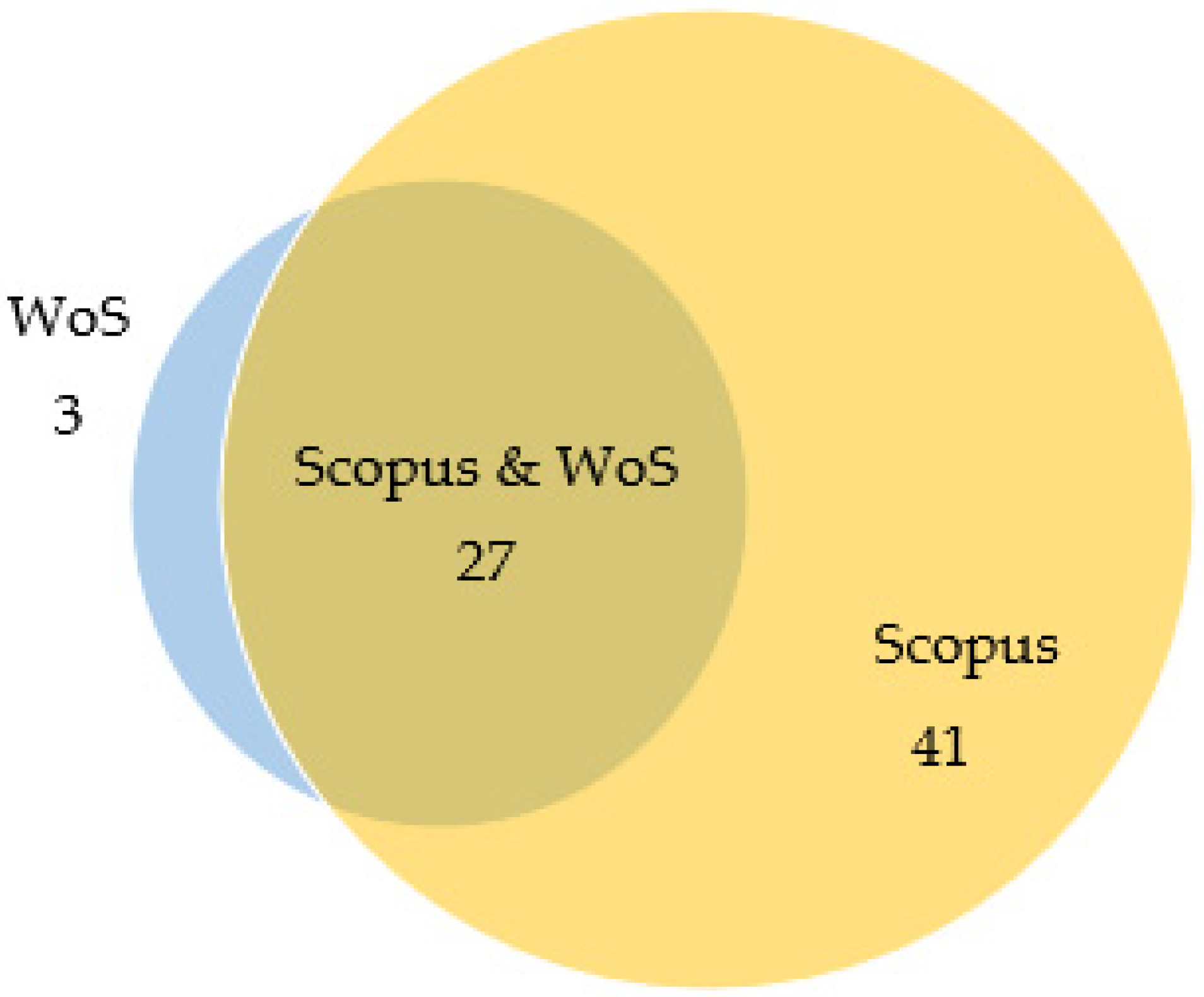



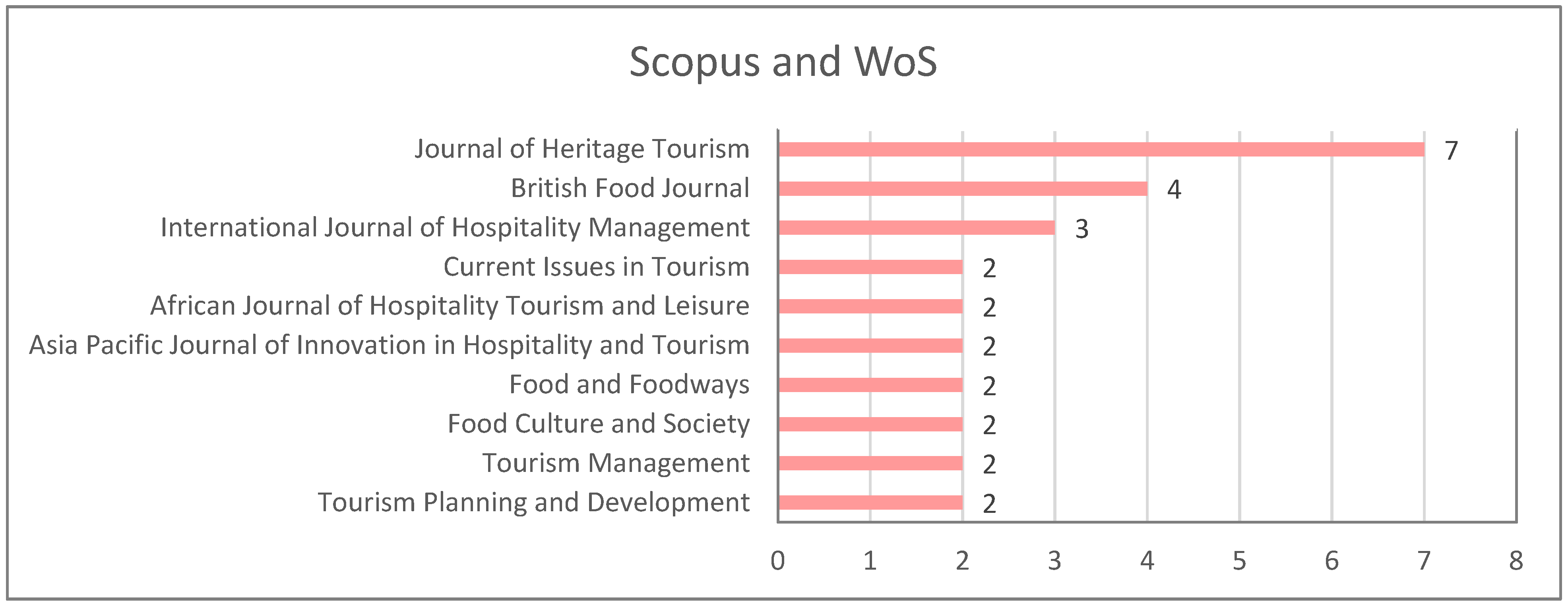
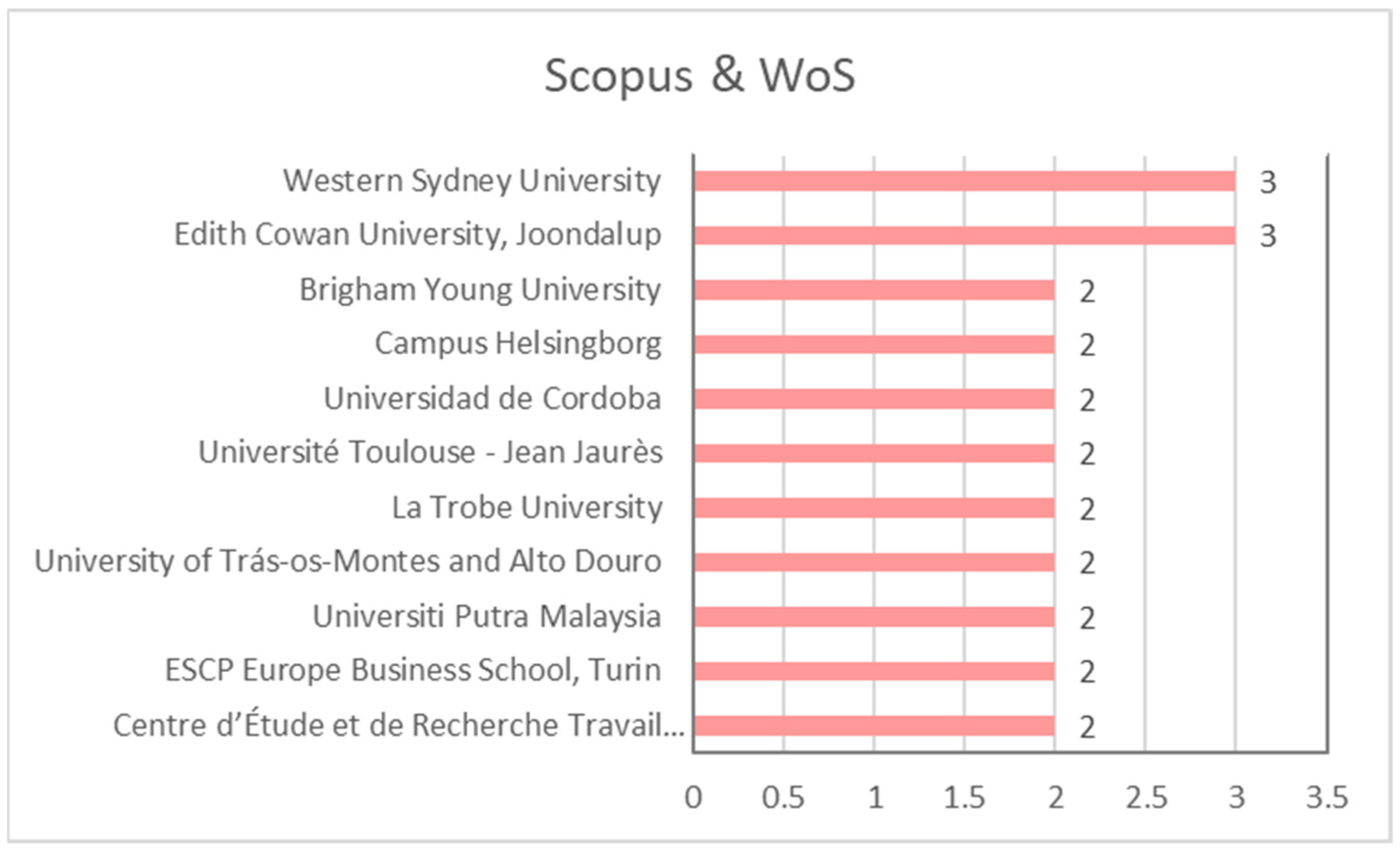
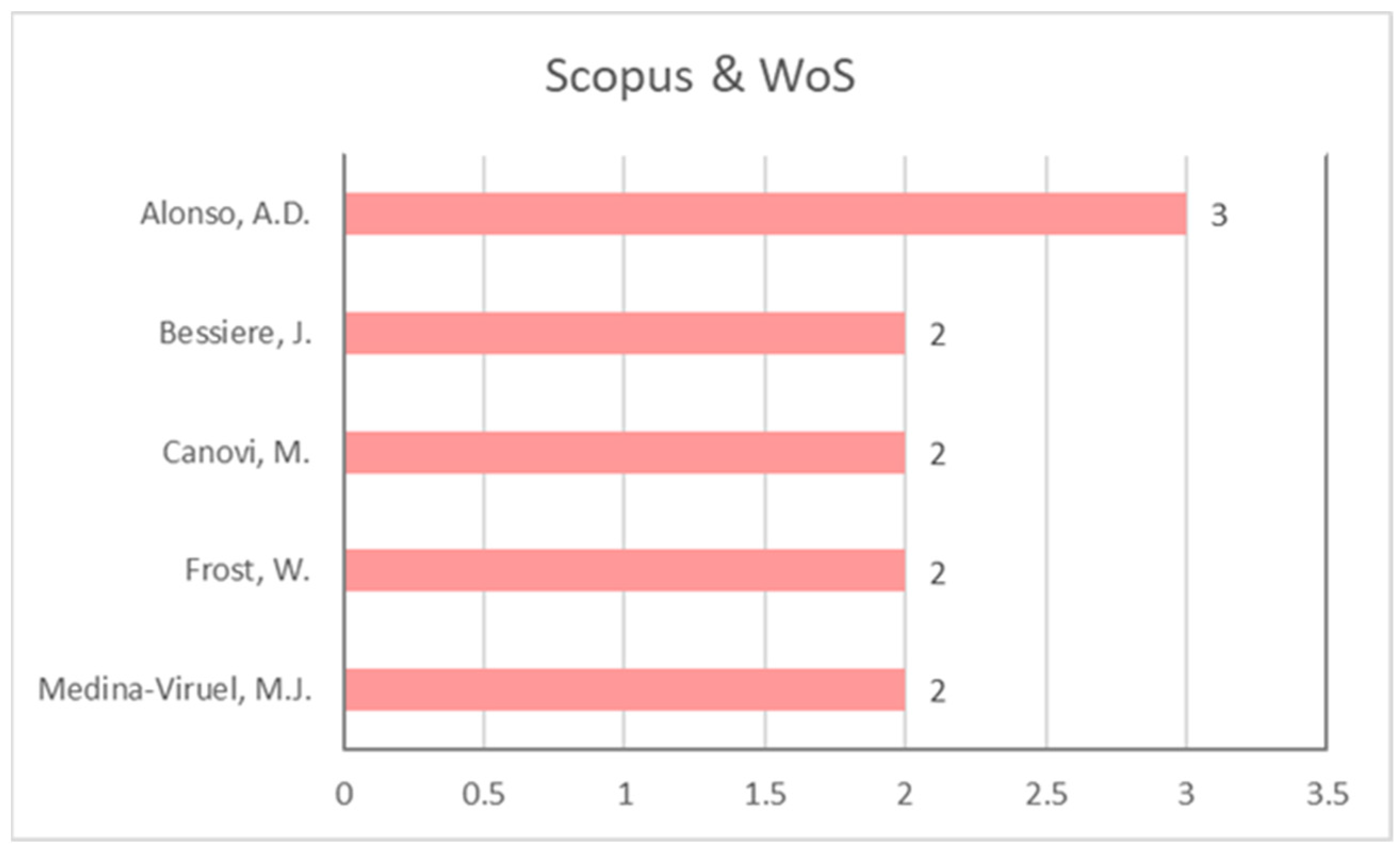

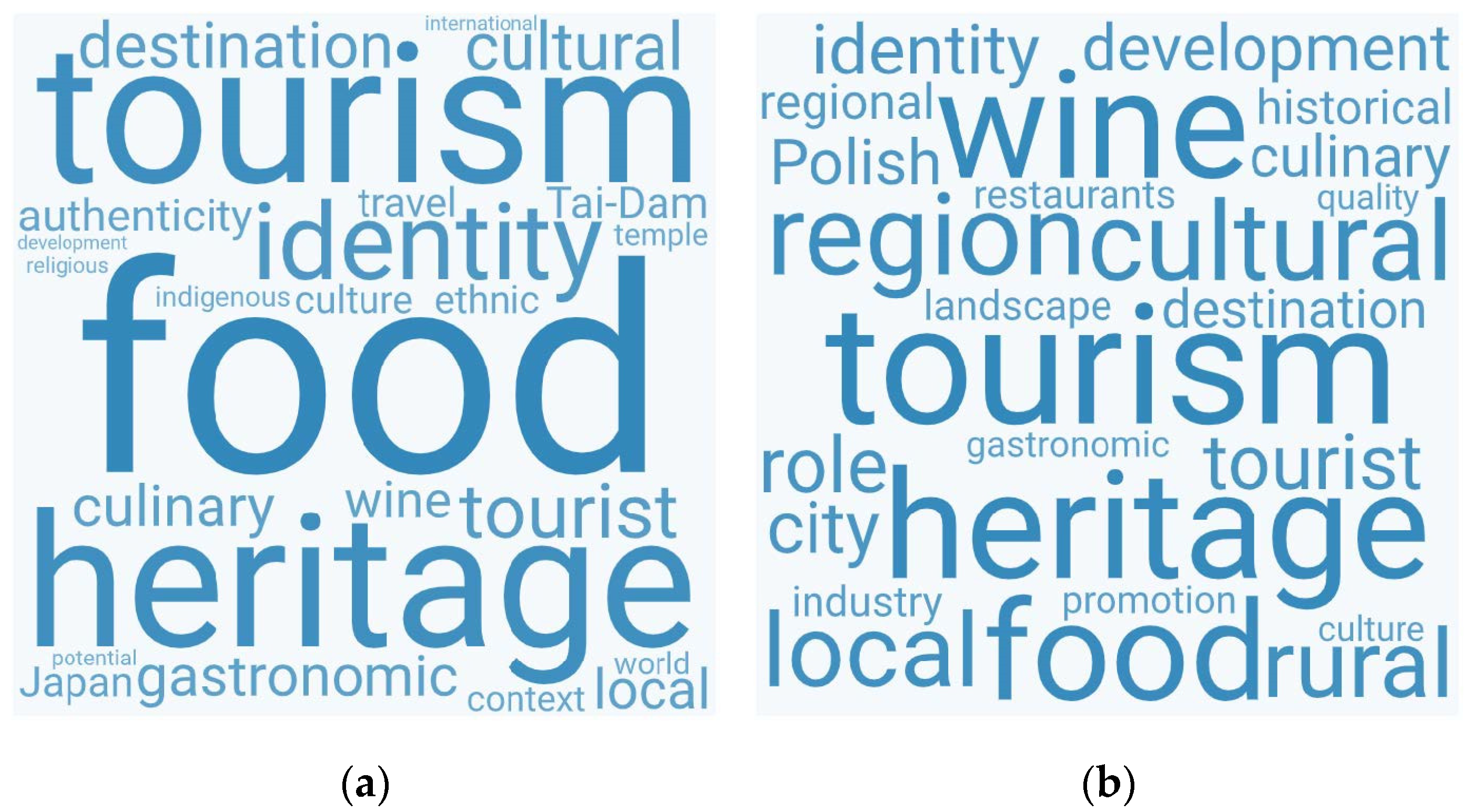
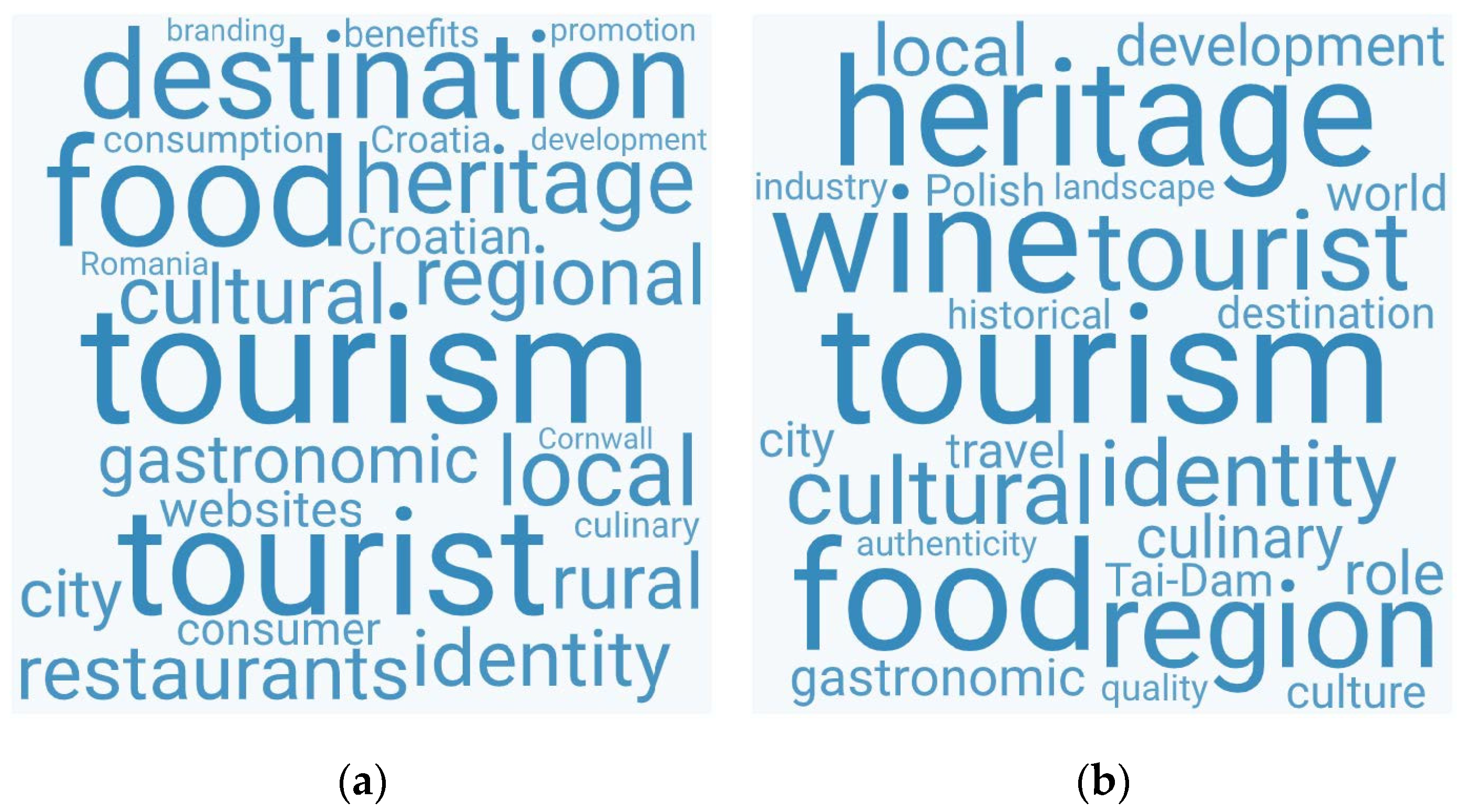
| Ref. | Year | Research Topic | Time Span | Database | Type | N |
|---|---|---|---|---|---|---|
| [51] | 2016 | The impact of UNESCO gastronomy elements | 1991–2013 | WoS | BA | 231 |
| [54] | 2017 | Wine tourism | 1994–2014 | Sc, WoS | BA | 238 |
| [55] | 2017 | Wine tourism and sustainability | 1994–2015 | Sc | LR | 43 |
| [58] | 2018 | Gastronomy tourism | 1985–2015 | Six DDBB | LR | 214 |
| [52] | 2018 | Food and gastronomy research | 1976–2016 | 16 journals | BA | 462 |
| [15] | 2019 | Food tourism and regional development | 1985–2017 | Sc, WoS | LR | 538 |
| [56] | 2019 | Wine tourism research | 1995–2014 | 20 vintages | LR | 176 |
| [57] | 2019 | Asian wine tourism research | 2000–2018 | Internet | LR | 89 |
| [13] | 2020 | Culinary intangible cultural heritage of UNESCO | 2000–2016 | EBSCO | BA | 28 |
| [59] | 2020 | Restaurant research | 2000–2018 | WoS | BA | 740 |
| [53] | 2020 | Destination food research | 2000–2018 | WoS | BA | 176 |
| Ref. | Year | Authors | Journal | Sc. | WoS |
|---|---|---|---|---|---|
| [69] | 2008 | Everett S., Aitchison C. | J. Sustainable Tour. | 233 | 222 |
| [70] | 2011 | Lin Y.-C., Pearson T.E., Cai L.A. | Tour. Hosp. Res. | 138 | |
| [71] | 2007 | Fox R. | Int. J. Hosp. Manage. | 124 | |
| [40] | 2010 | Bardhi F., Ostberg J., Bengtsson A. | Consum. Mark. Cult. | 71 | 67 |
| [27] | 2009 | Gyimóthy S., Mykletun R.J. | J. Vacat. Mark. | 66 | |
| [17] | 2013 | Bessière J. | J. Herit. Tour. | 54 | |
| [24] | 2013 | Bessiere J., Tibere L. | J. Sci. Food Agric. | 52 | 45 |
| [72] | 2014 | Contò F., Vrontis D., Fiore M., Thrassou A. | Br. Food J. | 38 | 29 |
| [73] | 2011 | Nilsson J.H., Svärd A.-C., Widarsson A., Wirell T. | Curr. Issues Tour. | 38 | 37 |
| [45] | 2013 | Ron A.S., Timothy D.J. | J. Herit. Tour. | 36 | |
| [74] | 2017 | Ganzaroli A., De Noni I., van Baalen P. | Tour. Manage. | 33 | 34 |
| [41] | 2013 | Alonso A.D., Krajsic V. | J. Herit. Tour. | 31 | |
| [3] | 2013 | Avieli N. | J. Herit. Tour. | 30 | |
| [75] | 2004 | Josiam B.M., Mattson M., Sullivan P. | Tour. Manage. | 28 | 25 |
| [76] | 2016 | Kim S., Iwashita C. | Tour. Recreat. Res. | 27 |
| Articles | Instances | Region | Articles | Instances |
|---|---|---|---|---|
| 36/46 (78%) | 415 (avg: 12) | Asia | 14/20 (70%) | 84 (avg: 6) |
| Europe | 22/26 (85%) | 331 (avg: 15) |
| C. | Period | Ref. | Subject | Method | Data Source | Destination |
|---|---|---|---|---|---|---|
| EU | 2001–2010 | [78] | heritage tourism | ethnographic portrait | people involved in food heritage | Languedoc, France |
| [71] | gastronomic identity | literature review | 7 national reports | Croatia | ||
| [69] | food tourism, regional identity | mixed | 3040 surveys, 3 reports and 12 interviews | Cornwall, England | ||
| [27] | culinary heritage | qualitative mixed | In depth interviews, printed media and ethnographic fieldwork | Voss, Norway | ||
| [79] | gastronomic heritage | web mining | 42 city-halls and 169 restaurants. | Romania | ||
| 2011–2020 | [73] | gastronomic heritage | qualitative | 9 semistructured interviews and systematic observations | North-western Italy | |
| [17] | food heritage | qualitative | 90 semistructured interviews | South-west France | ||
| [24] | food heritage | mixed | 480 survey questionnaires, observations and 30 interviews | South-west France | ||
| [80] | food heritage | descriptive | culinary events | Istria, Croatia | ||
| [72] | wine cultural heritage | deductive reasoning | rural development project | 10 European countries | ||
| [81] | wine and cultural heritage | quantitative | 249 visitors survey | Alto Douro, Portugal | ||
| [82] | food and beverage heritage | quantitative | 191 personal surveys | Catalonia, Spain | ||
| [83] | food identity | qualitative | 54 semistructured in depth interviews | Poland | ||
| [74] | cultural heritage | quantitative | TripAdvisor reviews of 575 restaurants | Venice, Italy | ||
| [84] | wine heritage | descriptive | wine regions | Portugal | ||
| [85] | wine heritage | descriptive | cultural landscape | Hvar, Croatia | ||
| [86] | culinary heritage | quantitative | 493 visitors survey | Poland | ||
| [87] | wine heritage, identity | qualitative | 20 winery owners semistructured interview | Langhe, Italy | ||
| [18] | wine heritage, regional identity | quantitative | technical reports and 29 tourism boards survey | Croatia | ||
| [88] | wine heritage, regional identity | quantitative | technical reports | Salamanca, Spain | ||
| [89] | gastronomic identity | descriptive | literature and guidebooks | Catalonia, Spain | ||
| [90] | food heritage | quantitative | 558 visitors survey | Cordoba, Spain | ||
| [91] | wine heritage, identity | qualitative | 28 wine producers survey | Langhe, Italy | ||
| [92] | gastronomic heritage, regionalidentity | qualitative | observations, autoethnography and 9 local actors’ interview | Gouda, The Netherlands. | ||
| [93] | wine heritage, identity | quantitative | 100 residents survey | Vila Nova de Gaia, Portugal | ||
| [94] | wine heritage | qualitative | 4 semistructured interviews | Tokaj, Hungary | ||
| AS | 2001–2010 | [40] | food heritage | qualitative | 28 American consumers interview | China |
| 2011–2020 | [70] | food identity | quantitative | 24 brochures, 35 websites, 83 stakeholders survey | Taiwan | |
| [95] | food identity | literature review | Ottoman travel literature | Turkey | ||
| [45] | food heritage | qualitative | observations and in depth interviews | Israel | ||
| [3] | culinary heritage | qualitative | ethnographic fieldwork, participant observation of food events | Hoi An, Vietnam | ||
| [96] | food and identity | literature review | Ottoman travel literature | Turkey | ||
| [97] | food, identity | qualitative | semi-formal conversations and observation | Mumbai, India | ||
| [76] | food heritage, regional identity | qualitative | 12 Japanese tourists’ interview | Gunma, Japan | ||
| [98] | food heritage | qualitative | 15 experts’ in-depth interview | Isfahan, Iran | ||
| [99] | culinary heritage | qualitative | Interviews and participant observation | Kyoto, Japan | ||
| [100] | gastronomic heritage | quantitative | 1132 visitors survey | Melaka and George Town, Malaysia | ||
| [101] | gastronomic heritage | mixed | 20 interviews, 470 questionnaires | Melaka and George Town, Malaysia | ||
| [102] | gastronomic identity | quantitative | 164 residents, 214 tourists survey | Gaziantep, Turkey | ||
| [103] | culinary heritage | quantitative | 450 tourists, 50 hoteliers | Rajasthan, India | ||
| [104] | culinary heritage | mixed | interviews, observations, 402 questionnaires survey | India | ||
| [105] | gastronomic identity | qualitative | experts and stakeholders’ interview | Loei, Thailand | ||
| [106] | winery’s identity | qualitative | 30 winery visitors interview | Yunnan, China | ||
| [107] | food heritage | quantitative | 98 stakeholders survey | Torqabeh, Iran | ||
| [108] | culinary heritage | qualitative | stakeholders’ in depth interview | Luzon Island, Philippines | ||
| [109] | wine heritage | qualitative | local actors’ interview, participant observation at wine tourism events | Yamanashi, Japan |
Publisher’s Note: MDPI stays neutral with regard to jurisdictional claims in published maps and institutional affiliations. |
© 2021 by the authors. Licensee MDPI, Basel, Switzerland. This article is an open access article distributed under the terms and conditions of the Creative Commons Attribution (CC BY) license (https://creativecommons.org/licenses/by/4.0/).
Share and Cite
Lin, M.-P.; Marine-Roig, E.; Llonch-Molina, N. Gastronomy as a Sign of the Identity and Cultural Heritage of Tourist Destinations: A Bibliometric Analysis 2001–2020. Sustainability 2021, 13, 12531. https://doi.org/10.3390/su132212531
Lin M-P, Marine-Roig E, Llonch-Molina N. Gastronomy as a Sign of the Identity and Cultural Heritage of Tourist Destinations: A Bibliometric Analysis 2001–2020. Sustainability. 2021; 13(22):12531. https://doi.org/10.3390/su132212531
Chicago/Turabian StyleLin, Min-Pei, Estela Marine-Roig, and Nayra Llonch-Molina. 2021. "Gastronomy as a Sign of the Identity and Cultural Heritage of Tourist Destinations: A Bibliometric Analysis 2001–2020" Sustainability 13, no. 22: 12531. https://doi.org/10.3390/su132212531
APA StyleLin, M.-P., Marine-Roig, E., & Llonch-Molina, N. (2021). Gastronomy as a Sign of the Identity and Cultural Heritage of Tourist Destinations: A Bibliometric Analysis 2001–2020. Sustainability, 13(22), 12531. https://doi.org/10.3390/su132212531








